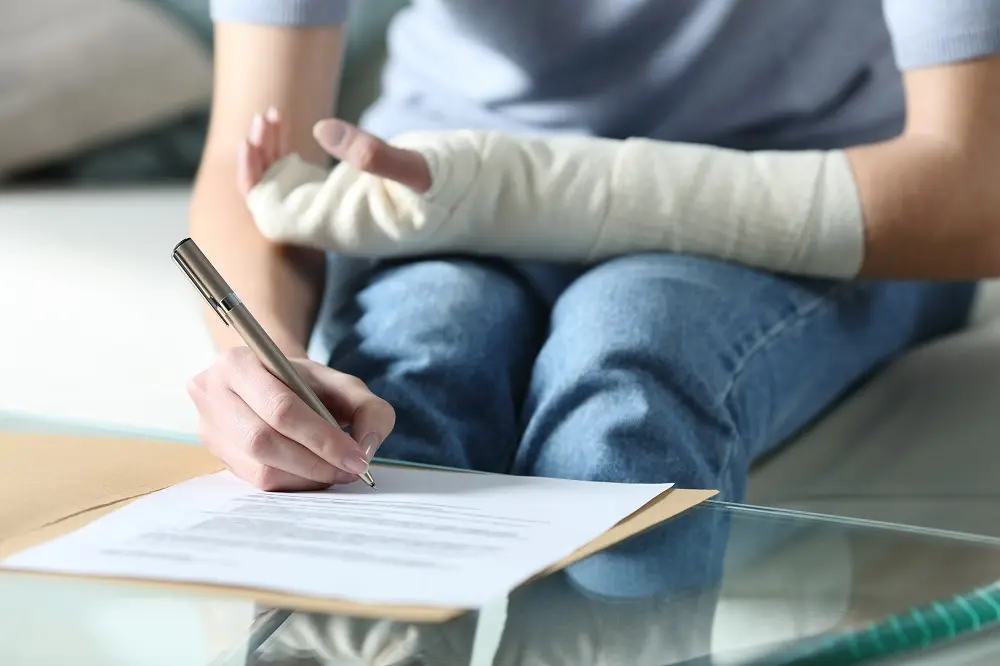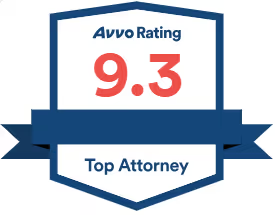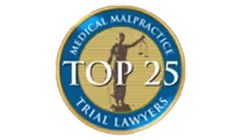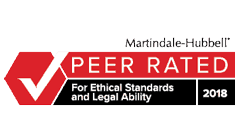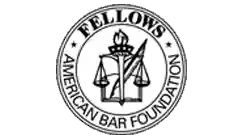You never expected to be here — injured, in pain, and unsure of what to do next. Work injuries occur frequently, and some are simply accidents where nobody is at fault. But when your work injury is caused by someone else’s negligence and careless actions, you shouldn’t have to suffer the consequences alone.
Understanding who’s truly responsible isn’t always straightforward. In many cases, someone other than your employer may be to blame. This situation may give rise to a third-party claim. Our skilled New York workplace accident lawyers will hold the responsible parties accountable and secure the maximum compensation possible for you.
What Is Third-Party Liability?
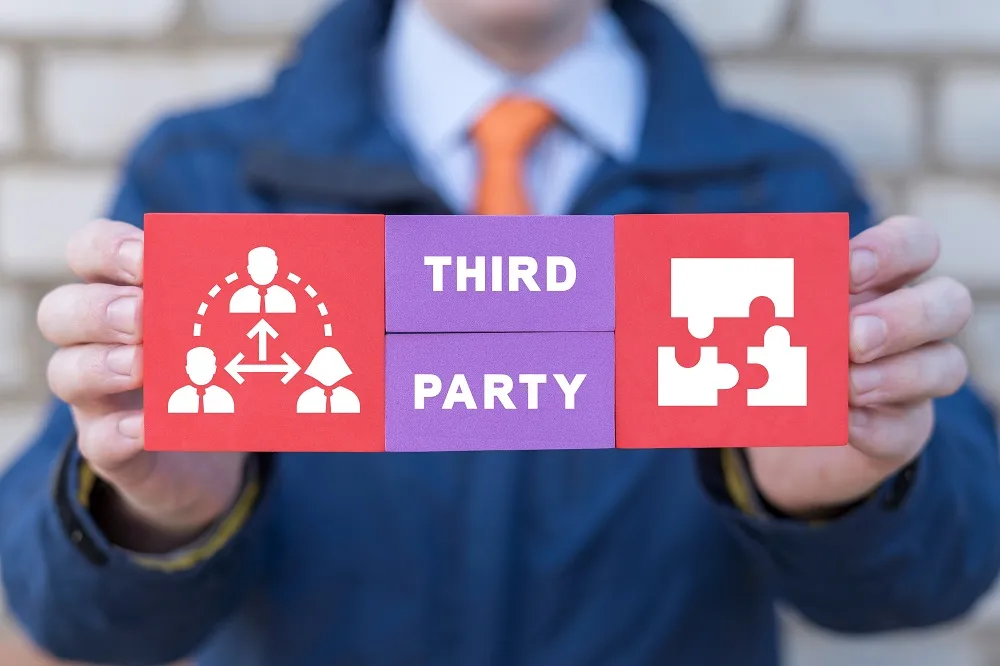
Third-party liability in workplace accidents refers to the legal responsibility of someone other than your direct employer. While New York’s workers’ compensation laws typically prevent you from suing your employer, they do not shield outside parties whose negligence may have contributed to your on-the-job injury.
When someone else creates or fails to prevent unsafe conditions, you may have the right to pursue a separate workplace injury claim for additional compensation. A first-party claim is filed with your own insurance company (e.g., no-fault), while a third-party claim targets another party whose negligence caused your work-related injury. Your eligibility to file a third-party claim depends on who was at fault and how the accident happened.
These third-party claims allow injured workers to recover damages beyond what workers’ comp provides, including:
- Pain and suffering
- Emotional distress
- Full wage loss
- Lost wages
- Future earnings
- Loss of future earning capacity
- Long-term care costs
Third-Party Lawsuits vs. Workers’ Compensation
Pursuing a third-party personal injury lawsuit doesn’t replace your right to workers’ comp — it adds to it. To understand how these two legal avenues work together, it’s important to compare their differences.
| Workers’ Compensation | Third-Party Lawsuit |
|---|---|
| No need to prove fault | Must prove negligence or strict liability |
| Limited benefits (medical, partial wage loss) | Full damages (pain & suffering, emotional harm, loss of life enjoyment) |
| Only applies to the employer | Can be brought against any negligent third party |
Who Can Be Held Liable for a Workplace Accident?
Workplace accidents in New York often involve more than just the employer. Thanks to powerful worker protections, such as New York Labor Law § 240(1) — commonly known as the Scaffold Law — third parties can be held strictly liable for gravity-related injuries involving falls or falling objects. Alongside § 200 and 241(6), these New York laws open the door to third-party liability claims when negligence or safety violations contribute to personal injuries on the job site.
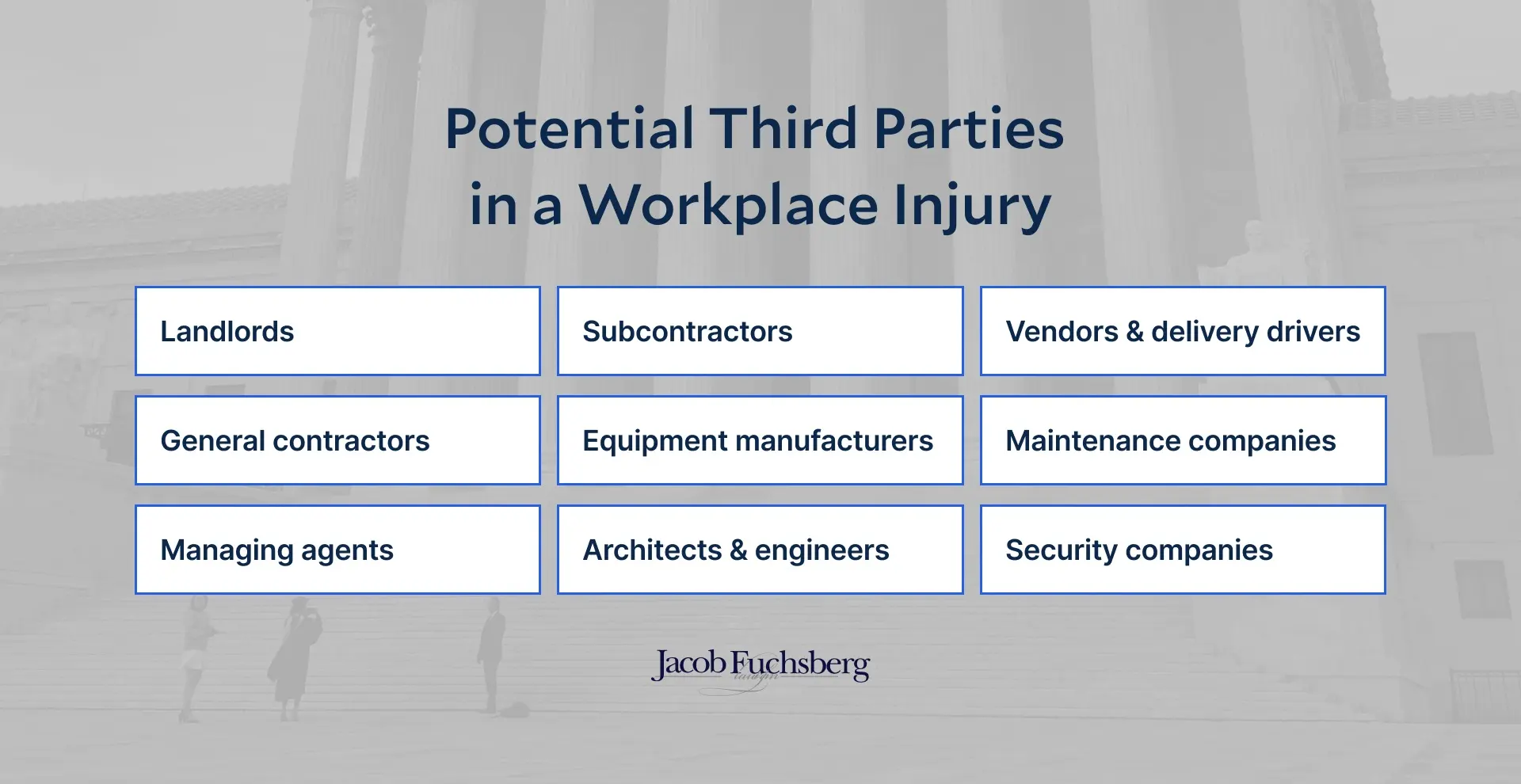
Below are the most common parties who may be held responsible:
Landlords
Property owners who retain control over construction areas must maintain a safe environment. If a landlord fails to repair known hazards, secure dangerous zones, or ensure compliance with safety codes, they can be liable, especially if they supervise or interfere with the work. This is common in commercial buildings where owners remain actively involved during renovations.
General Contractors
Under the Scaffold Law, general contractors can be held strictly liable for height-related injuries, even if they weren’t directly negligent. They’re also responsible for overseeing job site safety, coordinating with subcontractors, providing safety equipment, and ensuring that workers are protected from known hazards, such as unguarded edges or unstable scaffolding.
Managing Agents
These individuals or companies act on behalf of landlords to manage day-to-day property operations and maintenance. If they fail to address maintenance issues, disregard safety complaints, or ignore violations of labor safety standards, they may share liability for resulting injuries under premises liability or negligence laws.

Subcontractors
Trades such as electricians, plumbers, or roofers must adhere to strict safety standards. If their work creates hazardous conditions, like exposed wiring, unsecured ladders, or unmarked fall zones, they may be sued if those conditions result in personal injury to another worker or visitor on the site.
Equipment Manufacturers
If construction equipment, such as harnesses, ladders, scaffolds, or power tools, fails due to a dangerous product design or manufacturing defects, the injured party may pursue a product liability claim against the manufacturer, distributor, or seller. Missing safety warnings or poor instructions can also establish liability.
Architects & Engineers
These professionals are responsible for creating designs that are structurally sound and comply with applicable building codes and regulations. If an engineer's miscalculation or an architect’s flawed design contributes to a collapse, fall, or other dangerous condition, they can be held liable for resulting harm.
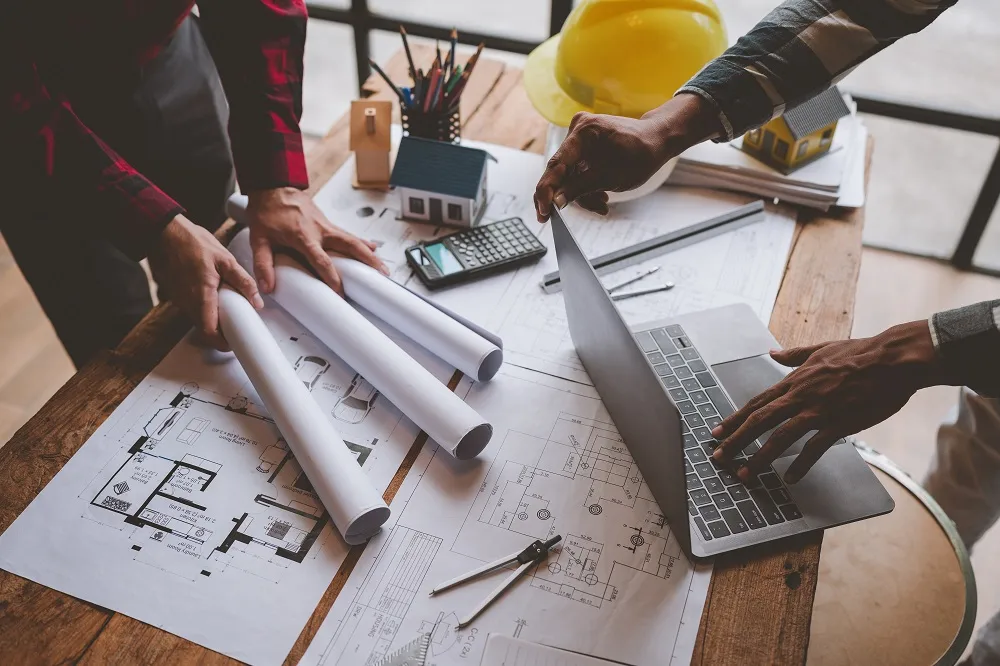
Maintenance Companies
Janitorial, elevator, or HVAC service companies often work on active job sites. If they leave water spills, misplace tools, block exits, or fail to report issues such as structural damage, they can be held liable for contributing to unsafe conditions that cause workplace injuries.
Vendors & Delivery Drivers
Delivery personnel transporting supplies to construction zones must follow all safety protocols. If they drop materials from heights, operate forklifts improperly, or obstruct walkways, they can be held responsible for any injuries their actions cause.
Security Companies
These third-party firms control access to the worksite. If they fail to prevent unauthorized entry, overlook safety threats, or don’t act on incident reports, they may face liability for injuries that occur due to their inaction or oversight.
How Liability Is Determined in New York City
Determining who is at fault requires examining the control, oversight, and knowledge each party had at the time of the accident, as well as the standards and rules they were required to follow by law. Factors include:
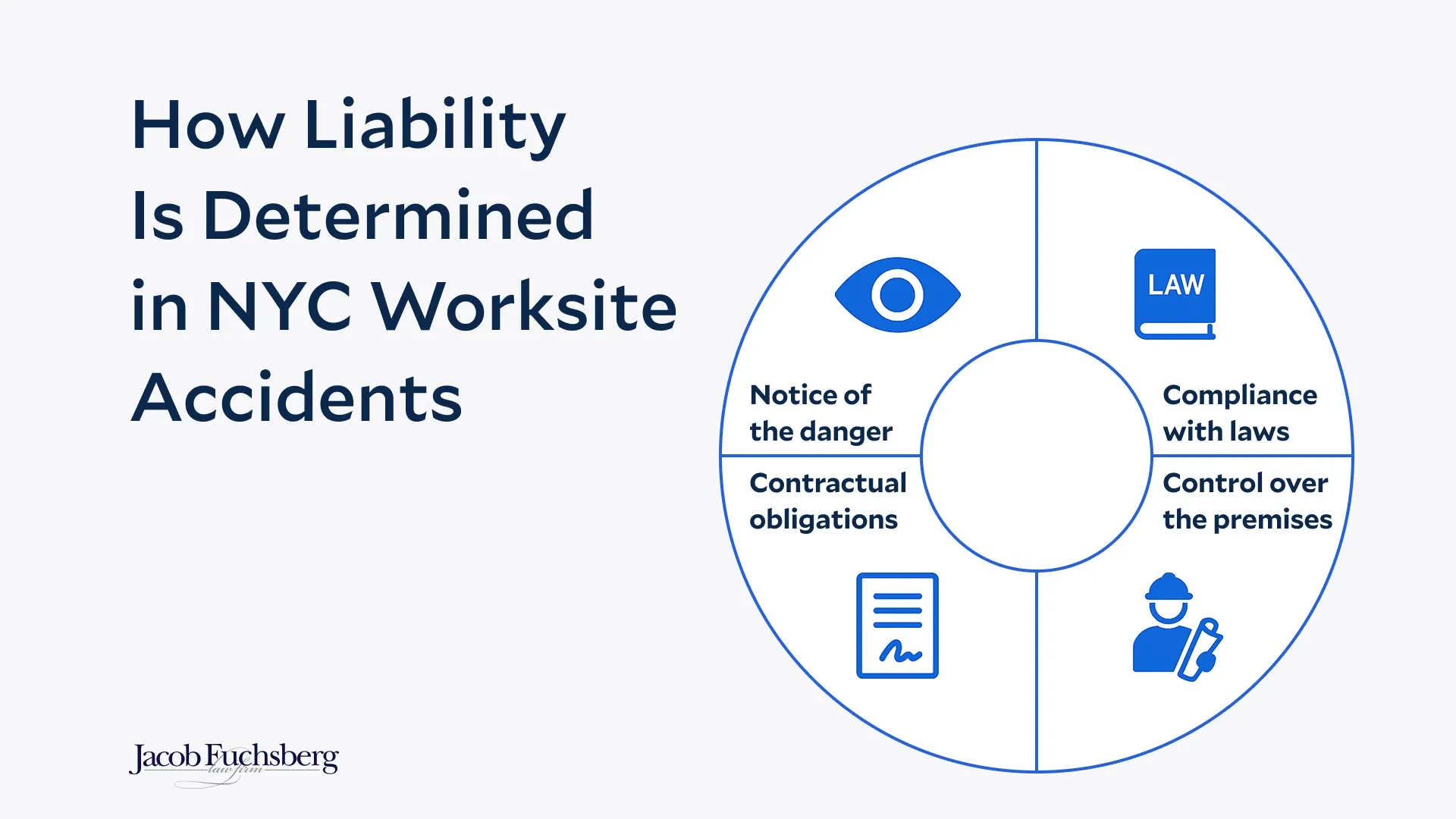
Contractual Obligations
Who was contractually responsible for maintaining a safe work environment? Construction contracts often assign specific safety duties to general contractors, subcontractors, or site supervisors. If a party failed to fulfill their assigned safety role, they may be held liable.
Control over the Premises
Which party had the authority to correct or remove the hazardous condition? A party with day-to-day control over the worksite or equipment typically bears more responsibility for ensuring safety.
Notice of the Danger
Did the party know about the dangerous condition, or should they have reasonably known through inspection or supervision? Actual or constructive knowledge is key to proving negligence.
Compliance with Safety Laws
Were New York Labor Laws (such as Sections 200, 240, or 241) and OSHA regulations followed? Violations of these laws can be strong evidence of liability, particularly in construction-related injury cases.
In many cases, multiple parties share responsibility, allowing the injured worker to bring personal injury claims against more than one defendant.
Proven Results: We’ve Been Fighting for Injured Workers and Their Families for Decades

At the Jacob D. Fuchsberg Law Firm, we’ve successfully represented workers in complex third-party liability cases for decades, and we also fight for those harmed by their own employers. Our law firm is dedicated to protecting individuals who have been injured, regardless of who is at fault.
Some of our recent results include:
- A catastrophic brain injury case involving a welder: We secured a substantial recovery for a client who was left in a vegetative state after a grocery store shelf collapsed on him while he was reinforcing it.
- A forklift accident case involving disputed employment status: A warehouse worker was run over by an unlicensed forklift operator. When the warehouse attempted to deny liability by claiming “special employer” status, attorney Aaron Halpern successfully proved otherwise, resulting in a favorable settlement.
- A gas explosion case involving a young construction worker: Attorney Jaehyun Oh obtained a $7 million settlement for a worker who sustained severe third-degree burns after being told to cut open an uninspected underground gas tank, in violation of OSHA standards.
- A product liability case involving a defective meat blender: Attorneys Joseph Lanni, Bradley Zimmerman, and Jaehyun Oh secured a multimillion-dollar settlement for an immigrant mother whose hand was severed by a dangerously unsafe meat blender sold without required safety guards or warnings.
These outcomes are just a few examples of our many successes and show our deep understanding of New York labor law, personal injury law, and our ability to aggressively challenge employer defenses. Whether the negligence comes from a contractor, property owner, or employer, we are here to fight for justice on behalf of injured workers.
FAQ
Were You Hurt at Work in New York? Get the Help You Need Now.
You may be entitled to more than workers' comp. If a third party caused your personal injury, you could pursue full compensation for medical treatment bills, lost future income, loss of consortium, and pain and suffering.
Seek Maximum Compensation for Your Workplace Injury with The Jacob D. Fuchsberg Law Firm
If you’ve been injured at work, workers’ comp may not be your only option. Third-party insurance claims can provide full compensation when someone else’s negligence contributed to unsafe conditions.
Our experienced New York workplace accident lawyers know how to navigate these complex cases and pursue every available avenue of winning the most money possible. Don’t wait — strict deadlines apply. Contact us today for a free consultation.

.svg)

